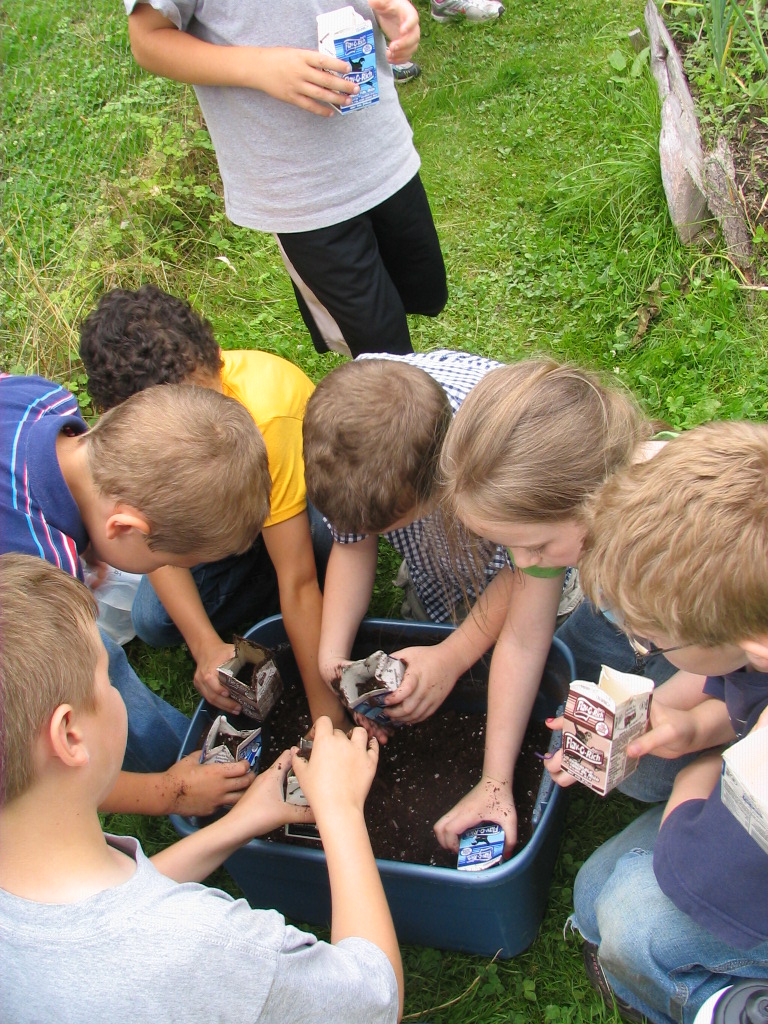Pine Mountain Settlement School
Series 13: EDUCATION
Series : ENVIRONMENTAL EDUCATION
Series : BOARDING SCHOOL Educational Program
Introduction

Environmental Education. Day Camp students work with potting soil. [day-camp-4.jpg]
TAGS: education, educational programming, Pine Mountain Settlement School, Harlan County, Kentucky, Boarding schools, Early Childhood Education, industrial education, environmental education, in the classroom, instruction, Youth Guidance Institute,
EDUCATION
Education is at the center of programming at Pine Mountain Settlement School. Whether it is a scheduled school group or an evening class for the local community, education is centered on programming that instructs. The fundamental educational ethos at the School, however, goes much deeper than just programming, It is an education with roots anchored in a deep heritage.
BOARDING SCHOOL
The earliest educational programming just following the founding of the School in 1913 was established for the disadvantaged very young boarding student. These early children came from homes and families that were impacted severely by many environmental, social, and governmental, and poor educational conditions in the Southern Appalachians in the first decades of the twentieth century. The lack of schools, the distance that was needed to travel to a school, poor roads, the loss of parents or a mother, the health condition of the children , and other factors determined the children’s access to the PMSS boarding school and schools generally. The lack of a sound educational base was evident but the solutions to the educational issues was slow to evolve.
As the settlement school idea grew and as Pine Mountain Settlement School grew, the age of the residential children increased. By the early 1930’s the School was accepting adolescents into the School and had developed a unique curriculum that combined the need for industrial training with the traditional grades. The 1930s and 1940s under the direction of Glyn Morris saw the School nationally recognized for its innovation and remediation of many of the educational issues in rural areas.
The unique ideas associated with the high school and that caught the attention of national educators were in the area of student guidance. The Guidance Institute that grew out of the Pine Mountain experiment led to work with leading educational scholars and by the late 1940’s incorporated into many schools county-wide and also country-wide as part of the Progressive movement.
COMMUNITY SCHOOL
While the innovative educational model created considerable excitement in the educational realm, it did not last. Following WWII the Pine Mountain School struggled to maintain its applicants and staffing. One observation was that the institution did not map well to the many changes in the rapid industrialization associated with coal in the surrounding region, improved transportation, and the Post-war economy. A Community Cooperative School was proposed to replace the boarding arrangement. The new school model that was implemented on the Pine Mountain School campus was governed by the Harlan County School System and largely funded by the county system and utilizing practice teachers provided by Berea College. This cooperative public school/private school arrangement persisted until a new elementary school at near-by Green Hill was completed. When completed the Green Hill School would accommodate the younger community students through busing and the older High School students would continue to be bused by the County Schools system over the mountain to Harlan County Schools.
LITTLE SCHOOL
Various programming was initiated to fill the gap left by the departure of the residential program, including a “Little School”. This program found national attention as a precursor of the “Headstart” early childhood education program adopted by the US Government to meet the growing need for early intervention in education. Pine Mountain staff member Mildred “Milly” Mahoney, who crafted the “Little School” program at Pine Mountain was an advisor for the educators who developed the popular national “Headstart” program.
ENVIRONMENTAL EDUCATION
By 1972 the staff at Pine Mountain was experimenting with environmental education programming and by 1978 the Board of Trustees at Pine Mountain encouraged by Mary Rogers and others to unanimously approve the institution of an Environmental Education program stating
The Trustees of the Pine Mountain Settlement School, realizing the alienation that exists between many modern-day people and their natural environment, believe that the abundant natural resources of the Pine Mountain Settlement School should be put to use in a program of environmental education.
The Board and the Director then proceeded to set forth the goals and the philosophy of that new direction, [See ENVIRONMENTAL EDUCATION EE]
Educational programs continue to evolve at the School and often reflect the interests of the Board, the Director or by social signals that new educational directions are a good fit with the over 100-year-old institution’s commitment to education within the Appalachian region.
SEE
SEE ALSO
EDUCATION Consumer Cooperative Community
ENVIRONMENTAL EDUCATION Lesson Plans and Supplementary Information 1973-1995
ENVIRONMENTAL EDUCATION The Green Book 1974 (Early Manual for EE Program)

